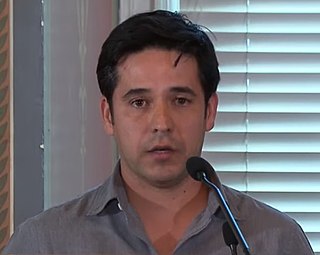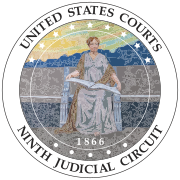Brown v. Board of Education of Topeka, 347 U.S. 483 (1954), was a landmark decision of the U.S. Supreme Court ruling that U.S. state laws establishing racial segregation in public schools are unconstitutional, even if the segregated schools are otherwise equal in quality. The decision partially overruled the Court's 1896 decision Plessy v. Ferguson, which had held that racial segregation laws did not violate the U.S. Constitution as long as the facilities for each race were equal in quality, a doctrine that had come to be known as "separate but equal". The Court's unanimous decision in Brown, and its related cases, paved the way for integration and was a major victory of the civil rights movement, and a model for many future impact litigation cases.
Milliken v. Bradley, 418 U.S. 717 (1974), was a significant United States Supreme Court case dealing with the planned desegregation busing of public school students across district lines among 53 school districts in metropolitan Detroit. It concerned the plans to integrate public schools in the United States following the Brown v. Board of Education (1954) decision.

Race-integration busing was a failed attempt to diversify the racial make-up of schools in the United States by sending students to school districts other than their own. While the 1954 U.S. Supreme Court landmark decision in Brown v. Board of Education declared racial segregation in public schools unconstitutional, many American schools continued to remain largely uni-racial. In an effort to address the ongoing de facto segregation in schools, the 1971 Supreme Court decision, Swann v. Charlotte-Mecklenburg Board of Education, ruled that the federal courts could use busing as a further integration tool to achieve racial balance.
Briggs v. Elliott, 342 U.S. 350 (1952), on appeal from the U.S. District Court for the Eastern District of South Carolina, challenged school segregation in Summerton, South Carolina. It was the first of the five cases combined into Brown v. Board of Education (1954), the famous case in which the U.S. Supreme Court declared racial segregation in public schools to be unconstitutional by violating the Fourteenth Amendment's Equal Protection Clause. Following the Brown decision, the district court issued a decree that struck down the school segregation law in South Carolina as unconstitutional and required the state's schools to integrate. Harry and Eliza Briggs, Reverend Joseph A. DeLaine, and Levi Pearson were awarded Congressional Gold Medals posthumously in 2003.

The NAACP Legal Defense and Educational Fund, Inc. is an American civil rights organization and law firm based in New York City.
Gustavo "Gus" C. Garcia was an American civil rights attorney. Garcia worked with fellow attorney Carlos Cadena in the landmark case Hernández v. Texas (1954), arguing before the US Supreme Court for the end of a practice of systematic exclusion of Hispanics from jury service in Jackson County, Texas. Even though Mexican Americans composed more than 10% of the county's population, no person of Mexican ancestry had served on a jury there and in 70 other Texas counties in over 25 years. The high court, led by Chief Justice Earl Warren, ruled that United States citizens could not be excluded from jury duty based on national origin, because such exclusion denied the accused a jury of his peers.

Sylvia Mendez is an American civil rights activist and retired nurse. At age eight, she played an instrumental role in the Mendez v. Westminster case, the landmark desegregation case of 1946. The case successfully ended de jure segregation in California and paved the way for integration and the American civil rights movement.
Green v. County School Board of New Kent County, 391 U.S. 430 (1968), was an important United States Supreme Court case involving school desegregation. Specifically, the Court dealt with the freedom of choice plans created to avoid compliance with the Supreme Court's mandate in Brown II in 1955. The Court held unanimously that New Kent County's freedom of choice plan did not adequately comply with the school board's responsibility to determine a system of admission to public schools on a non-racial basis. The Supreme Court mandated that the school board must formulate new plans and steps towards realistically converting to a desegregated system. Green v. County School Board of New Kent County was a follow-up of Brown v. Board of Education.
The Lemon Grove Case, commonly known as the Lemon Grove Incident, was the United States' first successful school desegregation case. The incident occurred in 1930 and 1931 in Lemon Grove, California, where the local school board attempted to build a separate school for children of Mexican origin. On March 30, 1931, the Superior Court of San Diego County ruled that the local school board's attempt to segregate 75 Mexican and Mexican American elementary school children was a violation of California state laws because ethnic Mexicans were considered White under the state's Education Code. Although often overlooked in the history of school desegregation, the Lemon Grove Case is increasingly heralded as the first victory over segregative educational practices and as a testimony to the Mexican immigrant parents who effectively utilized the U.S. legal system to protect their children's rights.

Mendez vs. Westminster: For All the Children/Para Todos los Niños is a 2003 American documentary film written, directed, and produced by Sandra Robbie. The film features Sylvia Mendez, Robert L. Carter, and others.

The League of United Latin American Citizens (LULAC) is the largest and oldest Hispanic and Latin-American civil rights organization in the United States. It was established on February 17, 1929, in Corpus Christi, Texas, largely by Hispanics returning from World War I who sought to end ethnic discrimination against Latinos in the United States. The goal of LULAC is to advance the economic condition, educational attainment, political influence, housing, health, and civil rights of Hispanic people in the United States. LULAC uses nationwide councils and group community organizations to achieve all these goals. LULAC has about 132,000 members in the United States.
The Westminster School District (WSD) is a school district in Orange County, California, established in 1872 and headquartered in Westminster. It operates schools in Westminster, Garden Grove, Huntington Beach, and Midway City.
Felicitas and Gonzalo Mendez High School is a public high school in the Boyle Heights neighborhood of Los Angeles, California, United States. It is also known as Felicitas and Gonzalo Mendez Learning Center.

Felicitas Gómez Martínez de Méndez was a Puerto Rican activist in the American civil rights movement. In 1946, Méndez and her husband, Gonzalo, led an educational civil rights battle that changed California and set an important legal precedent for ending de jure segregation in the United States. Their landmark desegregation case, known as Mendez v. Westminster, paved the way for meaningful integration and public-school reform.

School segregation in the United States was the segregation of students based on their ethnicity. While not prohibited from having schools, various minorities were barred from most schools, schools for whites. Segregation laws were dismantled in 1954 by the U.S. Supreme Court because of the successes being attained during the Civil Rights Movement. Segregation continued longstanding exclusionary policies in much of the Southern United States after the Civil War. School integration in the United States took place at different times in different areas and often met resistance. Jim Crow laws codified segregation. These laws were influenced by the history of slavery and discrimination in the US. Secondary schools for African Americans in the South were called training schools instead of high schools in order to appease racist whites and focused on vocational education. After the ruling of Brown v. Board of Education, which banned segregated school laws, school segregation took de facto form. School segregation declined rapidly during the late 1960s and early 1970s as the government became strict on schools' plans to combat segregation more effectively as a result of Green v. County School Board of New Kent County. Voluntary segregation by income appears to have increased since 1990. Racial segregation has either increased or stayed constant since 1990, depending on which definition of segregation is used. In general, definitions based on the amount of interaction between black and white students show increased racial segregation, while definitions based on the proportion of black and white students in different schools show racial segregation remaining approximately constant.

Duncan Tonatiuh is a Mexican-American author and illustrator of several award-winning children's books. The illustrations in his books are influenced by Pre-Columbian art. The themes in his stories relate to the Latino experience, with subjects that include social justice issues, art, history, and immigration. He is an advocate and activist for workers’ rights.

The Cypress Street Schoolhouse, also known simply as Cypress Schoolhouse, is historic former elementary school building in Orange, California built in 1931. It is a one story structure built in classic Spanish Colonial Revival architecture with stucco walls and a clay tile roof. The building hosted educational classes ranging from kindergarten to fifth grade. It is one of the last remaining public school buildings in Southern California that was used as a segregated school for Mexican American students. The school officially closed in 1944, just three years shy of the landmark California Supreme Court decision Mendez, et al v. Westminster School District which desegregated public schools in California. The school house is owned by Chapman University. Cypress Street Schoolhouse was added to the National Register of Historic Places on July 7, 2015.
Francisco Maestas et al. vs. George H. Shone et al. was a school desegregation case in Colorado involving Latino children in the early 20th Century. Filed in the Colorado district court, 12th district, in 1912 by Francisco Maestas against the Alamosa School District Superintendent and Board of Education in 1913, the case precedes Del Rio ISD v. Salvatierra by sixteen years, Alvarez v. Lemon Grove by seventeen years and Mendez v. Westminster by thirty-three years. The court ruled in favor of Maestas and the other Latino families.

Delgado V. Bastrop Independent School District was a Federal Circuit court case based out of Bastrop county that ruled against the segregation of Mexican-Americans in the public schools of Texas. The court's decision was argued on the standpoint of the Mendez et al. v. Westminster et al. court case and lack of Texas law for segregation of those of Mexican descent, and also stated that Mexican-Americans were separate from African-Americans as had been ruled in Plessy v. Ferguson. This case stated that except for the instance of separating individuals based on severe language difficulties in first grade, the school districts could not segregate their schools between Anglos and Mexican-Americans; moreover, the local school leaders and districts needed to take active action against it or they would also be liable for the results of segregated education. Though this case helped establish a baseline in the law against Mexican-American segregation in public schools, it took many more years and future lawsuits for action to follow through with the actual rulings of the court.

Lopez v. Seccombe. 71 F. Supp. 769. 1, US District Court for the Southern District of California, 1944. was a 1944 court case within the city and county of San Bernardino upon whether Mexican Americans were able to use the city's public pool at any time despite the cities restricted limits. It is one of the "first successful judicial challenges to racial segregation". It is a case regarding the discrimination Mexican Americans had faced in southern California in the 20th century.













